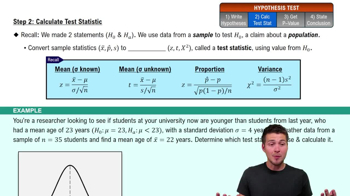Here are the essential concepts you must grasp in order to answer the question correctly.
Wilcoxon Signed-Ranks Test
The Wilcoxon signed-ranks test is a non-parametric statistical test used to compare two related samples or matched observations. It assesses whether their population mean ranks differ, making it suitable for paired data, such as before-and-after measurements. This test is particularly useful when the data does not meet the assumptions of normality required for parametric tests like the paired t-test.
Recommended video:
Step 2: Calculate Test Statistic
Wilcoxon Rank-Sum Test
The Wilcoxon rank-sum test, also known as the Mann-Whitney U test, is a non-parametric test used to compare two independent samples. It evaluates whether the distributions of the two groups differ by ranking all observations and comparing the sum of ranks between the groups. This test is appropriate when the data is ordinal or when the assumptions of normality for the independent t-test are not met.
Recommended video:
Step 2: Calculate Test Statistic
Non-parametric Tests
Non-parametric tests are statistical methods that do not assume a specific distribution for the data, making them versatile for various types of data, especially ordinal or non-normally distributed interval data. These tests, including the Wilcoxon tests, are advantageous when sample sizes are small or when the data violates the assumptions of parametric tests. They focus on ranks rather than raw data values, providing a robust alternative for hypothesis testing.
Recommended video:
Step 2: Calculate Test Statistic
 Verified step by step guidance
Verified step by step guidance Verified video answer for a similar problem:
Verified video answer for a similar problem:



 6:21m
6:21m